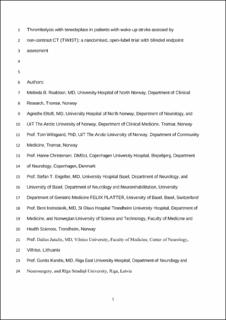| dc.description.abstract | Background - Current evidence supports the use of intravenous thrombolysis with alteplase in patients with wake-up stroke selected with MRI or perfusion imaging and is recommended in clinical guidelines. However, access to advanced imaging techniques is often scarce. We aimed to determine whether thrombolytic treatment with intravenous tenecteplase given within 4·5 h of awakening improves functional outcome in patients with ischaemic wake-up stroke selected using non-contrast CT.
Methods - TWIST was an investigator-initiated, multicentre, open-label, randomised controlled trial with blinded endpoint assessment, conducted at 77 hospitals in ten countries. We included patients aged 18 years or older with acute ischaemic stroke symptoms upon awakening, limb weakness, a National Institutes of Health Stroke Scale (NIHSS) score of 3 or higher or aphasia, a non-contrast CT examination of the head, and the ability to receive tenecteplase within 4·5 h of awakening. Patients were randomly assigned (1:1) to either a single intravenous bolus of tenecteplase 0·25 mg per kg of bodyweight (maximum 25 mg) or control (no thrombolysis) using a central, web-based, computer-generated randomisation schedule. Trained research personnel, who conducted telephone interviews at 90 days (follow-up), were masked to treatment allocation. Clinical assessments were performed on day 1 (at baseline) and day 7 of hospital admission (or at discharge, whichever occurred first). The primary outcome was functional outcome assessed by the modified Rankin Scale (mRS) at 90 days and analysed using ordinal logistic regression in the intention-to-treat population. This trial is registered with EudraCT (2014–000096–80), ClinicalTrials.gov (NCT03181360), and ISRCTN (10601890).
Findings - From June 12, 2017, to Sept 30, 2021, 578 of the required 600 patients were enrolled (288 randomly assigned to the tenecteplase group and 290 to the control group [intention-to-treat population]). The median age of participants was 73·7 years (IQR 65·9–81·1). 332 (57%) of 578 participants were male and 246 (43%) were female. Treatment with tenecteplase was not associated with better functional outcome, according to mRS score at 90 days (adjusted OR 1·18, 95% CI 0·88–1·58; p=0·27). Mortality at 90 days did not significantly differ between treatment groups (28 [10%] patients in the tenecteplase group and 23 [8%] in the control group; adjusted HR 1·29, 95% CI 0·74–2·26; p=0·37). Symptomatic intracranial haemorrhage occurred in six (2%) patients in the tenecteplase group versus three (1%) in the control group (adjusted OR 2·17, 95% CI 0·53–8·87; p=0·28), whereas any intracranial haemorrhage occurred in 33 (11%) versus 30 (10%) patients (adjusted OR 1·14, 0·67–1·94; p=0·64).
Interpretation - In patients with wake-up stroke selected with non-contrast CT, treatment with tenecteplase was not associated with better functional outcome at 90 days. The number of symptomatic haemorrhages and any intracranial haemorrhages in both treatment groups was similar to findings from previous trials of wake-up stroke patients selected using advanced imaging. Current evidence does not support treatment with tenecteplase in patients selected with non-contrast CT. | en_US |

